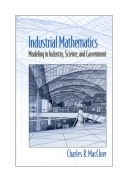|
||
• wydawnictwa polskie
• Zamów informacje o nowościach z wybranego tematu • kontakt
• Cookies na stronie |
INDUSTRIAL MATHEMATICS.MODELING IN INDUSTRY,SCIENCE AND GOVERNMENTMACCLUER C.R.wydawnictwo: PRENTICE HALL , rok wydania 2000, wydanie Icena netto: Industrial Mathematics Modeling in Industry, Science, and Government Charles R.MacCluer ISBN 0-13-949199-6 307pp Preface Mathematics is unreasonably effective in resolving seemingly intractable problems. The process proceeds in three steps: model the external world problem as a mathematical problem, solve the mathematical problem, then interpret the results. A mathematician in government or industry will be involved at all three steps. This book is for students about to enter the workforce. They may be well grounded in the fundamentals of mathematics but not in its practice. Although changing of late through the efforts of COMAP, SIAM, and NSA, the graduating student has little experience in modeling or in the particular extensions of mathematics useful in industrial problems. They may know power series but not the z-transform, orthogonal matrices but not factor analysis, Laplace transforms but not Bode plots. Most certainly they will have no experience with problems incorporating the unit $. Mathematicians in industry must be able to see their work from an economic viewpoint. They must also be able to communicate with engineers using their common dialect, the dialect of this book. Each chapter begins with a brief review of some relevant mathematics which may require further elaboration by the instructor. Then the industrial extension of this same material is introduced via typical applications. The routines which occur in the flow of text are not merely enrichment but instead are an integral part of the text itself. One central thrust of this book is to demonstrate the power of interweaving analytic with computing methods during problem solving. Many exercises require the student to experiment with, or to modify, the MATLAB routines provided. Tedious retyping of the routines is unnecessary since all routines will be available at our anonymous ftp site math.msu.edu down the path pub/maccluer/mm. Other exercises ask the student to generate code themselves. A certain number of exercises are in fact projects, requiring data collection, experimentation, or consultation with industrial experts. This book is aimed at the senior undergraduate or Master's student of mathematics, engineering, or science. The writing style is by design sparse and brief. Księgarnia nie działa. Nie odpowiadamy na pytania i nie realizujemy zamówien. Do odwolania !. |


